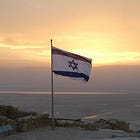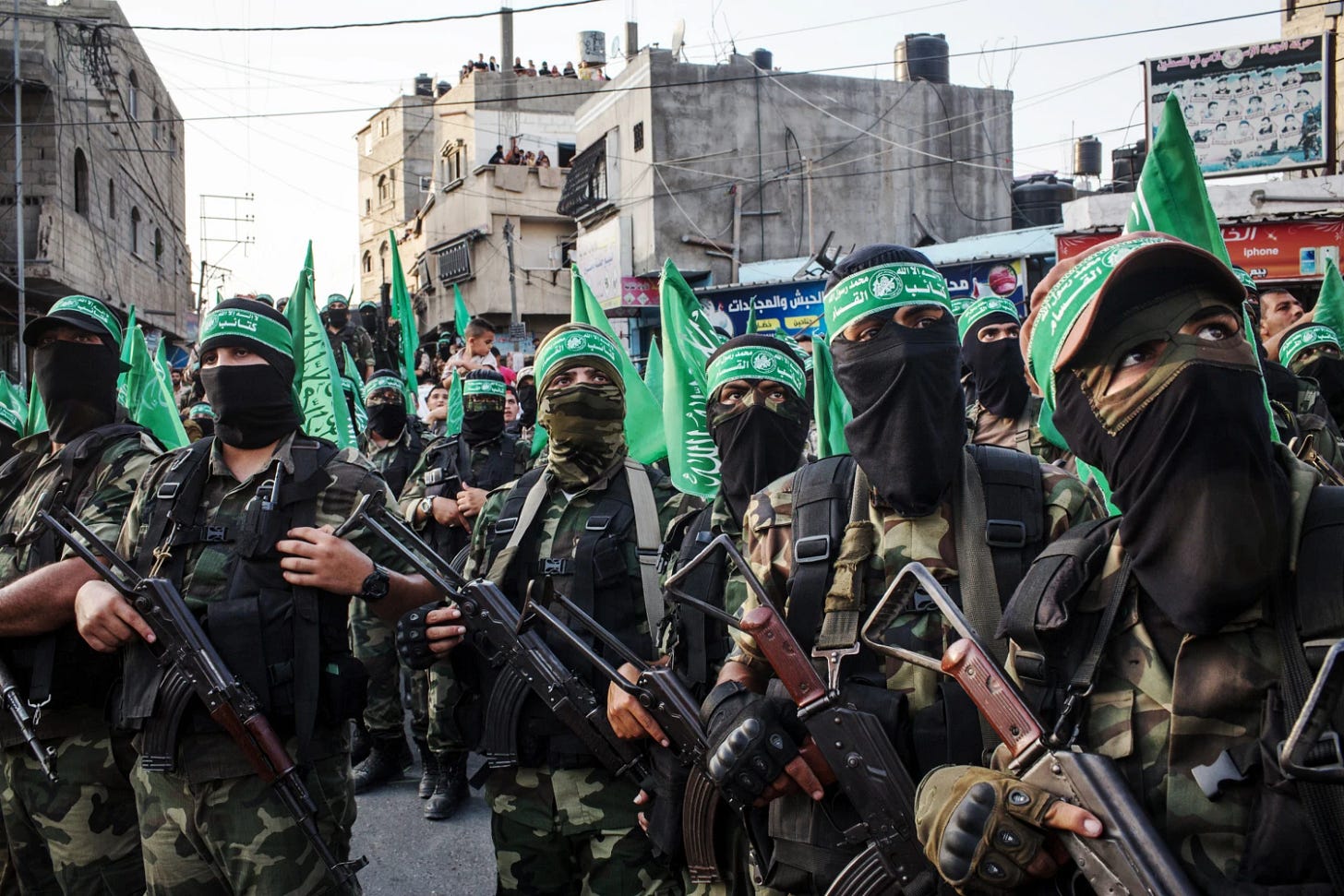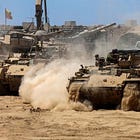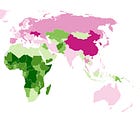A Palestinian State is a Threat to Us All
Recognizing a Palestinian state means legitimizing terror, undermining allies, and surrendering Western civilization to those sworn to destroy it.
Don’t miss our Deep Dive: “The Palestinians Are the Colonizers”. It’s a must-read.
This analysis is free, but with Premium Membership you get MORE. Join today.
NOTE: The absurdity of alleged American “allies” Canada, Britain, Australia, France, Portugal, Belgium, et al. recognizing a Palestinian state that doesn’t exist — and likely never will — is dangerously naive. It is another example of what Gad Sadd calls “suicidal empathy”.
But it doesn’t have to make sense. To Western leftist elites, the “Two-State Solution” is less a foreign policy proposal than a religious dogma. Never mind that the Palestinians have consistently, repeatedly rejected that “solution” since 1947. The only Palestinian state that has ever been acceptable to the Palestinians, then or now, is one that stretches “from the river to the sea”, which is to say, one that includes all of what is now Israel.
Sorry: that is never, ever going to happen.
But if it did, we should all be very, very concerned. The Islamists refer to Israel as “the little Satan”, to the United States as “the great Satan”. And they couldn’t be clearer: they’re coming for us next.
The truth is, a Palestinian state — or at least one west of the Jordan — is a threat to us all. It must never be allowed to exist. — RDM
by Bruce Thornton
September 23, 2025
As Israel plans to finally end the decades of terrorist slaughter by Hamas, some Western nations — many functionally antisemitic — are plaguing Israel yet again with a plan to bring to the UN a resolution for creating a Palestinian state, thus rewarding Hamas and other jihadist terrorists for murdering Jews.
In addition to the blood-libels of Israelis — like “starving” and wantonly “slaughtering” innocent Gazans that lard this “plan” — there’s the stale reprise of diplomatic magical thinking to conjure a nation for a people who never had one in the ancient homeland of the Jews they want to murder and plunder.
Of course, the Europeans and other oil-cringe geopolitical milquetoasts are relying on the UN, which has long supported the fancifully named “Palestinians” — a propaganda tactic used to gull Westerners into believing that Israel sits on a sacred Palestinian “stolen” homeland. All freedom-loving nations, especially the U.S., should make every effort to stop the UN and feckless NATO nations from recharging the Jew-haters for another attempt to repeat Hitler’s Holocaust.
Moreover, the UN for decades has lost any credibility when it comes to Israel by successfully convincing Western useful idiots to ignore history and morality, and to bully Israel into not just letting a sadistic enemy off the hook, but bestowing on them a Potemkin “state” that in fact would be a bigger platform for continuing the murder of Jews.
And don’t forget the malign role the UN has played in the vicious abuse of the only democratic state in the region. For example, General Assembly Resolution 2708 (1970) stated that the UN “reaffirms its recognition of the legitimacy of the struggle of the colonial peoples and peoples under alien domination to exercise self-determination and independence by all the necessary means at their disposal.” Notice how that phrase repeated the communist moral idiocy of “any means necessary,” and exempts not just the brutal violence of “national liberation” movements, but also legitimized terrorism from the codified restraints limiting armed conflict.
One of the most infamous crimes of the “diplomatic engagement” promoted by the UN were the Oslo Accords, two agreements between Israel and the terrorist PLO negotiated in 1993 and 1995. The pacts were marketed as the foundations for a peace treaty and a Palestinian state, with the creation of the Palestinian Authority awarded some self-government authority, including armed police powers, over the so-called “West Bank,” the Orwellian euphemism for the ancient Jewish territorial heartland of Judea and Samaria.
The folly of making deals with terrorists sworn to destroying Israel quickly became obvious. Terror attacks between 1994-1999 totaled 215, just about the same number as before the pact. Carnage continued to escalate in subsequent years. In response to further Israeli concessions — offering not only an independent Palestinian state but 94% of all Palestinian demands — terrorist Yasser Arafat, the first leader of the PA, unleashed the “Second Intifada,” a series of vicious attacks which in five years murdered over a thousand Israelis, mostly civilians.
Moreover, recently, according to Palestine Media Watch, “‘9,750 terrorist prisoners are now recognized by the PA as eligible for monthly terror rewards, up from 4,300 prior to October 7. This means the PA — not Hamas, the supposedly “peaceful” PA — is committing to pay nearly NIS 60 million [$16.4 million] a month to terrorist prisoners. The PA has recognized Hamas’ Martyr count, and a total of 38,983 new Martyrs’ families are currently eligible for terror rewards. This means nearly 55 million shekels [$14.7 million] in additional monthly payments to the families of Martyrs.’”
Your foreign aid budget pays for this.
Despite this bloody object-lesson in the PA’s jihadist bona fides, the latest “two-state solution” scheme, spearheaded by France and the UK, has proposed a Palestinian state, as the Gatestone Institute reports, “‘predicated’ on commitments from the Palestinian Authority (PA) to undergo critical governance reforms, as well as excluding the Iran-backed Hamas terrorist group from a future Palestinian government.”
For the Europeans to banish Hamas, but welcome the PA — with its long history of terrorist slaughter of Israeli civilians, and serial violations of pacts and agreements —suggests some in the West are objectively rife with antisemitism, bespeaking a despicable moral idiocy.
Finally, this long failed process of state-building and “diplomatic engagement” is one of the bloodiest repudiations of the “rules-based international order” that has mesmerized the foreign policies of the West with its feckless idealism replacing traditional realism about human nature’s flaws and passions, and the malign, parochial interests of complex, diverse states.
The fact is, there is no global “harmony of interests,” no “community of nations,” no “citizens of the world,” no “international laws” properly understood that can promote and enforce justice across hundreds of diverse nations — with different principles, cultures, and beliefs that can be trumped by alien foreign ones. Nations deem, as Lord Palmerston, UK Prime Minister in the late 19th Century, put it, “We have no eternal allies, and we have no perpetual enemies. Our interests are eternal and perpetual, and those interests it is our duty to follow.”
Next, “diplomat engagement” and negotiations amongst enemies are usually a chimera when it comes to settling conflict, often leading to bad faith and appeasement. As George Shultz reminded us, “Negotiations are a euphemism for capitulation if the shadow of power is not cast across the bargaining table.” Without a concentrated mind that believes a rival or enemy will use force to protect an agreement’s conditions, every promise is born to be violated.
Last, most important is the warning from the historian of Soviet atrocities, Robert Conquest, who wrote in Reflections on a Ravaged Century about Cold War diplomacy: “Since diplomats’ forte is negotiation, they believe negotiation to be a good in itself. . . But the Soviets did what their interests required when the alternative is less acceptable, and negotiation was merely a technical adjunct.”
Thus, diplomatic negotiation is not necessarily a sincere desire to reach a peaceful accommodation to both sides of a conflict, but rather a means to a serve a nationalist or political purpose. This means that seeing clearly the adversary’s true interests and purposes — rather than projecting our own beliefs and goods onto the enemy’s — is the most important factor in diplomacy. “It is easy enough,” Conquest writes, “to fall into the trap of thinking that others think, within reason, like ourselves. But this trap is precisely the error that must be avoided in foreign affairs.”
The wisdom of this realism has been lost in the postwar West, and the effect on foreign policy has been a plague for Israel. The “trap” Conquest identifies has been particularly perilous in our relations with Islamic states. The secular, if not outright Christophobic, prejudices of modernity have made us dismissive of faith, and prone to ignore the deep, 14-centuries-old precepts and doctrines of Islam.
In contrast to the West, as Middle East scholar Bernard Lewis points out, “in most Islamic countries, religion remains a major political factor,” for “most Muslim countries are still profoundly Muslim in a way and in a sense that most Christian countries are no longer Christian. . . in no Christian country at the present time can religious leaders count on the degree of belief and participation that remain normal in the Muslim lands.”
This is significant in no small part because the moral requirements of Islam are very different indeed from those of Christianity.
Given its Islamic neighbors, Israel is perforce an exception to the West’s dismissive ignorance, and has for decades been plagued by the well-meaning, but often dangerously misguided, advice of its Western allies, who think that Western ideals like liberal democracy, national sovereignty, human rights, and economic growth will achieve by “diplomatic engagement” the solution to a conflict born in 14 centuries of religious doctrines and faith.
Israel now sits on the brink of destroying a fanatic, savage, genocidal enemy that has murdered tens of thousands of Jews living in their ancestral homeland. The Western nations like France and the UK need to stop trying to solve its domestic problems brought on by feckless immigration policies and suicidal anti-carbon energy policies, and let Israel finish the job of securing its homeland, its future, and ours.
— This essay originally appeared at Front Page Magazine.










Sorry A Palestinian State is a Joke.
The documentary you're referring to is "One Day in Gaza," a 2019 film directed by Olly Lambert and produced as a collaboration between BBC and PBS Frontline. It focuses on the events of May 14, 2018—one of the deadliest days during the Great March of Return, a series of largely non-violent protests by Palestinians in Gaza that ran weekly from March 30, 2018, to December 27, 2019 (spanning approximately 88 weeks, during which protesters faced repeated use of live fire and other force from Israeli Defense Forces snipers and troops).
3 sources
It aired on BBC Two in England (and across the UK) on May 13, 2019.
2 sources
The film was scheduled to air the following day on PBS Frontline in the United States but was pulled at the last minute and replaced with a repeat broadcast of a report on the Mueller investigation; PBS cited a decision to prioritize "timely" content but stated it would air the documentary later—however, it was never broadcast on PBS stations in the US.
3 sources
There are no confirmed reports of it being aired on broadcast TV in other countries, though it may have been shown via BBC international services or local affiliates in some regions.It is currently available to stream or download for free in various places online, including:YouTube (search for "One Day in Gaza" documentary; multiple uploads exist, such as at https://www.youtube.com/watch?v=los2x3umyDg).
Internet Archive (full video with additional context at https://archive.org/details/OneDayInGaza2019Documentary).
BBC iPlayer (potentially geo-restricted to the UK).
Torrent downloads (e.g., via the magnet link provided in some advocacy sources, though use at your own risk).
7 web pages